

3/2006
Restoration architect Mary B. Brush, AIA, enjoys a “magical” professional exchange

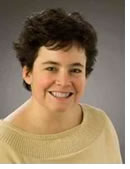 Mary Brush, AIA, director
of the Preservation Group at Klein and Hoffman, Chicago, spent six months
in France as the 2005 laureate of the Richard Morris Hunt Fellowship,
a professional honor for which one American architect is chosen every
two years to meet and work with restoration architects and professionals
throughout France. The $25,000 fellowship is an exchange of information,
techniques, and professional practices of architects and practitioners
in the preservation fields of each country. Brush focused her inquiries
on building envelope restoration as practiced in France to study substantive
differences between the professional practices in the U.S. and France.
Mary Brush, AIA, director
of the Preservation Group at Klein and Hoffman, Chicago, spent six months
in France as the 2005 laureate of the Richard Morris Hunt Fellowship,
a professional honor for which one American architect is chosen every
two years to meet and work with restoration architects and professionals
throughout France. The $25,000 fellowship is an exchange of information,
techniques, and professional practices of architects and practitioners
in the preservation fields of each country. Brush focused her inquiries
on building envelope restoration as practiced in France to study substantive
differences between the professional practices in the U.S. and France.
Back in Chicago, Brush has worked on projects including the exterior walls of Louis Sullivan’s Gage Building and of Burnham and Root’s Rookery Building.
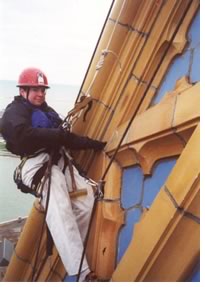 Fluency in French is one of the program requirements. How does language
play a role in this fellowship?
Fluency in French is one of the program requirements. How does language
play a role in this fellowship?
Brush: I can’t imagine having this professional experience without
the ability of language. The fellowship is funded equally between the
American Architectural Foundation and the French Heritage Society, but
the Americans in France are primarily organized by the French Historical
Society. They established my itinerary and wrote all my letters of introduction.
I would generally be with the lead architect, and I would shadow him
or her for the two or three weeks I was in the office. I would go to
all their job sites and meetings, and find out how they do their work,
and by doing that, also found out more things about how the offices were
run. Without language, I wouldn’t have been able to have those
conversations. When I was on a job site, I could be talking to the architect,
but a couple of times the contractors would pull me away and say, “I
want to show you this sculpture I just finished over around the other
side of the building.” I’d just go wandering off with other
people because they were proud of their work and they wanted to show
me what they had done, even though it wasn’t necessarily the architect’s
focus. By having language, other people wanted to show me things, which
was the biggest compliment.
How did your days/weeks play out?
Brush: There was nothing typical from one day to another; I’ve
never moved so fast in my life. In the U.S. system of cataloguing our
historic structures, we have significant buildings, which are our most
important buildings, and then we have contributing buildings that are
still considered very important, but maybe not the highest level of importance.
France also has a two-tier system, but they have protections so that
only architects who are specifically educated and trained and who have
moved their way up the hierarchy are working on the most important buildings.
There it’s very difficult to get to work on restoration jobs. That’s
in contrast to this country, where I recently restored a Louis Sullivan
building. The client was not required to take on an architect with my
level of restoration experience.
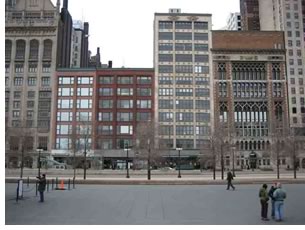 From
one day to another, I would never know where I was going to be. The architects
would say, “Ok, meet me at the train station at
6 in the morning,” and sometimes that would be the first time I
met them. I met my first host architect on my first Monday in Paris,
and then Tuesday we were in Rome. The restoration architects are responsible
not only for historic properties in France, but those the government
still owns through strategic political marriages or her Colonial empire.
They are divided up by country, so my first host architect lives in Lyon,
and also has regions of Provence that he’s responsible for, but
he also is responsible for the French historic monuments in Italy. So
that second day I was in Rome where he was restoring the Villa Medici
(purchased by Napoleon and today the home of the French Academy). From
these travels, I would learn how they were doing their work, both from
their values of preservation, which vary culturally from ours, and then
also the techniques that are available to them. Some I can import, I
hope, and apply them to thought processes here. It’s just an issue
of finding the techniques and the right projects, and clients, and finding
something that is competitive financially. Hopefully I can import some
ideas to my next projects, and then find the right contractors and see
if they can all be put together.
From
one day to another, I would never know where I was going to be. The architects
would say, “Ok, meet me at the train station at
6 in the morning,” and sometimes that would be the first time I
met them. I met my first host architect on my first Monday in Paris,
and then Tuesday we were in Rome. The restoration architects are responsible
not only for historic properties in France, but those the government
still owns through strategic political marriages or her Colonial empire.
They are divided up by country, so my first host architect lives in Lyon,
and also has regions of Provence that he’s responsible for, but
he also is responsible for the French historic monuments in Italy. So
that second day I was in Rome where he was restoring the Villa Medici
(purchased by Napoleon and today the home of the French Academy). From
these travels, I would learn how they were doing their work, both from
their values of preservation, which vary culturally from ours, and then
also the techniques that are available to them. Some I can import, I
hope, and apply them to thought processes here. It’s just an issue
of finding the techniques and the right projects, and clients, and finding
something that is competitive financially. Hopefully I can import some
ideas to my next projects, and then find the right contractors and see
if they can all be put together.
 What is the difference in attitudes?
What is the difference in attitudes?
Brush: History in Europe seems to be so much more present and valued
than it is here. For example, if a building there, say a church, has
lost its congregation or a protected building has lost its ownership—and
granted they have a different level of state financing and support
for their preservation projects—their attitude is “well,
we don’t know what to do with these buildings right now, but
our generation, or two or three generations from now may have the idea
to make this building functional. Just because we don’t know
what to do with it, doesn’t mean we should take that opportunity
from them and tear it down and make it go away forever.” To find
here a beautiful building that has been abandoned and now all of a
sudden has the funding to do a proper restoration is a challenge. My
office is currently involved in some work with the Uptown Theater,
which is a beautiful theater in Chicago that has been abandoned for
20 years. It would be fantastic to be able to put together the right
financing package to find the right purpose to make the building not
only look good after its restoration but to be functional and alive
again with activities. But here it’s a different attitude—we
have a lot of litigation, insurance issues, and financial reasonings
that are different priorities than they are in France. We need to learn
to value the mix of our important historic buildings. Architecture
has to keep moving forward but we do need to keep the buildings that
truly are important on our streets.
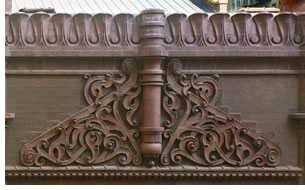 We
have tax incentives, and several of my clients have taken advantage of
them, but there just needs to be more support for us to really be able
to say that preservation is financially attractive to ownership. In France,
grants and other funding may account for between 15 percent to even 100
percent of construction costs, depending on the building, the value,
and the extent of work. However, that system is changing because the
country has to re-evaluate its finances. They have so many historic monuments
they are running out of money. They can’t address everything
they would want to address. I don’t know how long that system is
going to last in France, but it’s certainly lovely while it exists.
We
have tax incentives, and several of my clients have taken advantage of
them, but there just needs to be more support for us to really be able
to say that preservation is financially attractive to ownership. In France,
grants and other funding may account for between 15 percent to even 100
percent of construction costs, depending on the building, the value,
and the extent of work. However, that system is changing because the
country has to re-evaluate its finances. They have so many historic monuments
they are running out of money. They can’t address everything
they would want to address. I don’t know how long that system is
going to last in France, but it’s certainly lovely while it exists.
What are some of the parallels you encountered?
Brush: Ultimately, the work of a restoration architect is the same in
the two countries. The buildings exist, which means we can’t
find out the extent of every problem before we do the work. It is typically
not possible to dismantle the entire building in order to discover
all the conditions prior to the restoration design. We can only look
at it and take small pieces apart and look behind it and at other areas
of the wall, and say, “from my experience, this is the design
solution, and we’ll come up with the details and prepare the
documents for the contractors.” That process is the same whether
I’m doing it here in Chicago or they are doing it there in France.
The difference is that there it is a 300-year-old building, and for
me, I’m on the outside of a 50-story building.
 From that standpoint, working as a restoration architect is very similar.
In a similar limestone building, we both have to find the right cleaning
technique because neither one of us wants to damage the stone with the
wrong process. They employ different approaches to cleaning limestone
that are starting to be popular here, but aren’t necessarily competitive
yet. They clean a lot of sculpture with laser techniques, which is possible
here, but it’s the rare project that can afford to do it. In Chicago,
we have a lot of terra cotta, very popular in the buildings of the 1880s
and onward, whereas France has very few terra-cotta buildings, so we
have a material concept that is foreign to them, so some things can’t
be applied to our work here. Masonry wall consolidation is very popular
in France, and it’s starting to come here, but it’s not nearly
as sophisticated. It’s a process of knowing it’s there, but
that it’s not yet financially viable for a lot of my projects.
From that standpoint, working as a restoration architect is very similar.
In a similar limestone building, we both have to find the right cleaning
technique because neither one of us wants to damage the stone with the
wrong process. They employ different approaches to cleaning limestone
that are starting to be popular here, but aren’t necessarily competitive
yet. They clean a lot of sculpture with laser techniques, which is possible
here, but it’s the rare project that can afford to do it. In Chicago,
we have a lot of terra cotta, very popular in the buildings of the 1880s
and onward, whereas France has very few terra-cotta buildings, so we
have a material concept that is foreign to them, so some things can’t
be applied to our work here. Masonry wall consolidation is very popular
in France, and it’s starting to come here, but it’s not nearly
as sophisticated. It’s a process of knowing it’s there, but
that it’s not yet financially viable for a lot of my projects.
What are your lingering impressions from your
RMH Fellowship?
Brush: It’s nice to be back in Chicago, and, thankfully, my firm,
Klein and Hoffman, was very supportive and gave me a leave of absence
while I was away. It’s nice to be back at my office and productive
again. I hope there have been professional and social friendships and
relationships that have been established while I was in France that I’ll
enjoy for the rest of my life.
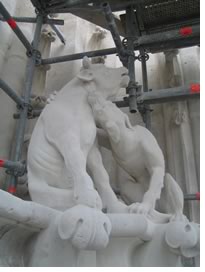 For as many differences as I expected to see—because their buildings
are just at a different level than our buildings and our history is so
much newer than it is in Europe—it’s clear that our history
is equally valid; it just represents a different timeframe. I was surprised
at finding how many similarities there are in the language of being an
architect.
For as many differences as I expected to see—because their buildings
are just at a different level than our buildings and our history is so
much newer than it is in Europe—it’s clear that our history
is equally valid; it just represents a different timeframe. I was surprised
at finding how many similarities there are in the language of being an
architect.
As the AIA works to raise its profile through the 150th-anniversary celebration as more than just a club of architects, but as a service to the community by working as a catalyst for livable communities, the fellowship helps crystallize the value of preservation and restoration toward the goal of creating livable communities. For example, the AIA Illinois Board of Directors is trying to recognize the architects and clients that inspire the projects that turned around a community through good architecture. A lot of times that’s new design, but it is also in preserving our heritage and how that affects our communities through recognizing preservation efforts.
The entire experience was so much more than I possibly imagined. The French people in general, the architects, and the contractors—everyone was just so wonderfully welcoming. It was walking around with people so inspired by restoration. It just came down to magic.
Copyright 2006 The American Institute of Architects.
All rights reserved. Home Page ![]()
![]()
Established in 1990, the fellowship is named for Richard Morris Hunt, the first American architect to study at the Ècole des Beaux-Arts and one of the founders of the AIA. A jury of international professionals selected Brush from three finalist candidates.
Brush holds an undergraduate degree in architecture from William Smith College, an MS in historic preservation from PennDesign at the University of Pennsylvania, and an MArch from University of Illinois Chicago.She is a current member of the AIA Illinois Board of Directors, has been an active Young Architect in the AIA Chicago chapter, and has participated in myriad preservation conferences and organizations including DoCoMoMo/US/International, Association for Preservation Technology, Chicago Architecture Foundation, and the Landmark Preservation Council of Illinois. She speaks fluent French.
Brush can be reached at mbrush@kleinandhoffman.com. Read more about
her travels at her Web site. ![]()
Images: All images courtesy of the architect.
![]()